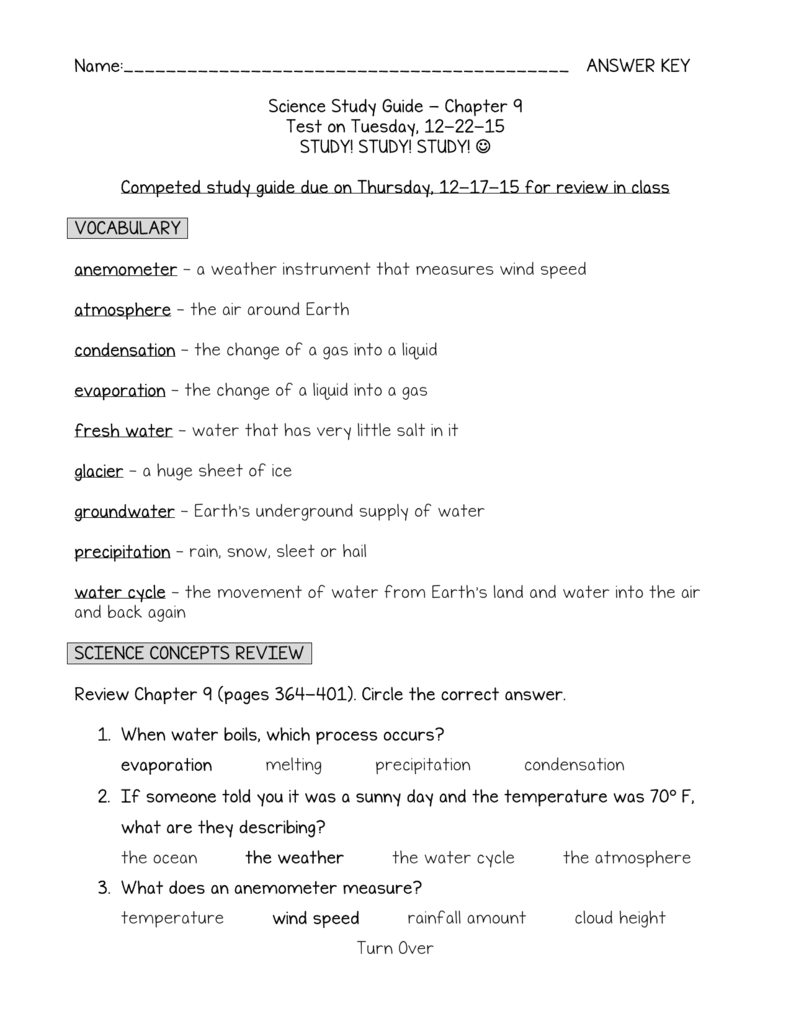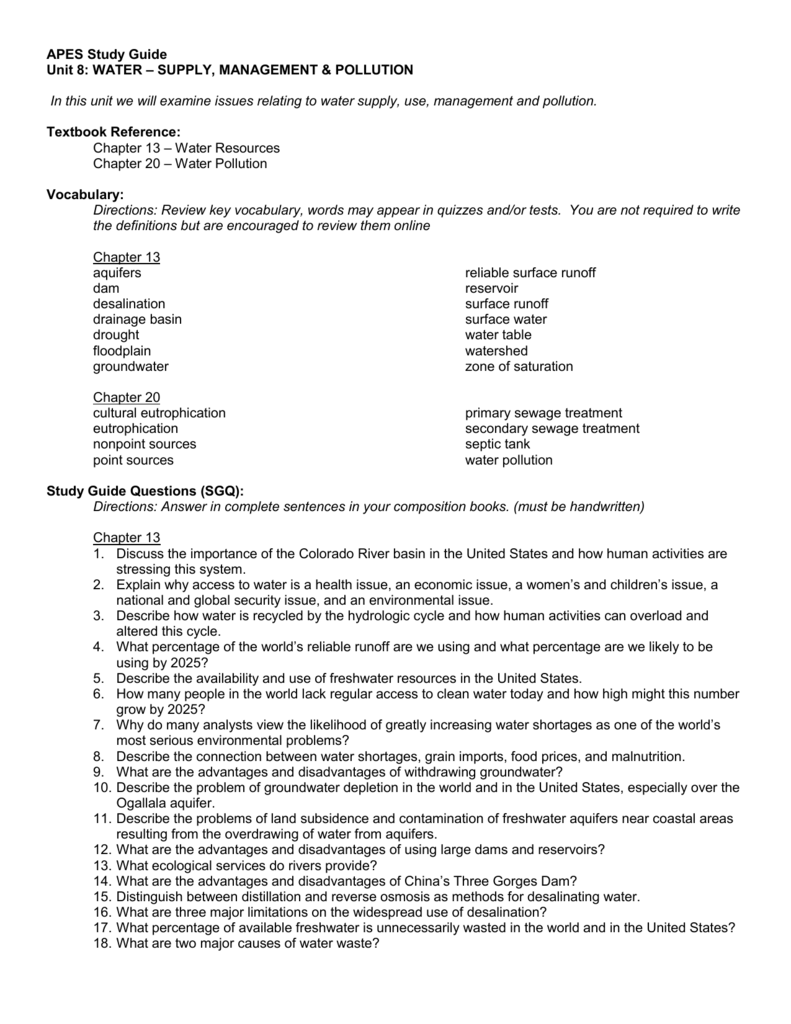Surface Water Study Guide
Chapter 9 Study Guide. The volume of water that moves past a point on a river in a given time is called the river’s FLOW. The energy that produces ocean waves comes from WIND blowing across the water’s surface. After the last ice age, stranded ice blocks left behind by continental glacier melted and formed a.
- Water bodies in the proposed study area has multiple beneficial uses, and exists. Part of the Central Valley, while silica is high, reflecting the volcanic material.
- Exam Study Materials. ABC Formula and Conversion Sheets: Water and Wastewater. What kind of calculator can I use? T he AMP Calculator Guidelines will help you find out if your calculator is allowed. Take a copy of this document with you to the exam! Surface Water Monitoring Surface Water.
Engage students in thinking about how water moves through sediments. Tell students that much of their water comes from groundwater and that water moves from the ground to the surface. Ask:. Why does water move through gravel more quickly than it moves through clay? (Gravel is more permeable than clay.). Would it be easier to get water out of sand or out of gravel? (It would be easier to get water out of gravel because the pore spaces are larger. The water will move more quickly through larger pore spaces.) 2. Discuss the role of uncertainty in the scientific process.
Tell students that science is a process of learning how the world works and that scientists do not know the “right” answers when they start to investigate a question. We can see examples of scientists' uncertainty in the forecasting of precipitation amounts. Have students go to. Ask them to input their zip codes, hit “Go”, scroll down to the bottom of the page, and click on the “Hourly Weather Graph”. This page shows the hourly weather forecast for your area. The first box shows the predicted temperature and dew point (along with wind chill or heat index, when applicable). The second box shows the predicted wind speed and direction.
The third box shows the predicted sky cover (i.e. Cloud cover), relative humidity, and chance for precipitation. The boxes below that line show whether the precipitation is likely to be rain, snow, freezing rain, or sleet. Point out the line for precipitation potential (the brown line). Ask:. Why is the precipitation shown as a “%”? (Precipitation is dependent on other factors, such as relative humidity and temperature. It is more likely to precipitate when the temperature is the same as or lower than the dew point.).
Chapter 9 Surface Water Study Guide Answers
If there is a likelihood of precipitation, why is the amount of rain/snow shown as ranges? (The amount of precipitation that will fall is dependent on the amount of moisture in the atmosphere. The atmosphere is continually changing, so the amounts are guidelines for what could happen rather than perfect predictions.).If there is no or low likelihood of precipitation in your area, you may want to find a different location (in the United States) that has a higher likelihood of precipitation.
You can look at a current weather map (radar) to find where in the United States precipitation is happening currently. Your students will then be able to see scientists' forecasts of precipitation amounts represented as a range overlaid on the bar graphs. Tell students they will be asked questions about the certainty of their predictions and that they should think about what scientific data are available as they assess their certainty with their answers. Encourage students to discuss the scientific evidence with each other to better assess their level of certainty with their predictions. Introduce the concept of systems in Earth's water resources. Tell students that forecasting what will happen to Earth's fresh water supplies is a complicated process because there are many different interacting parts.
Tell students that scientists think about how one part of the system can affect other parts of the system. Give students a simple example of a system, as described in the scenario below. On an island, there is a population of foxes and a population of rabbits. The foxes prey on the rabbits.
Vocabulary Term Part of Speech Definition Encyclopedic Entry aquifer Noun an underground layer of rock or earth which holds groundwater. Confined aquifer Noun layer of water-bearing rock between two layers of less permeable rock. Conservation Noun management of a natural resource to prevent exploitation, destruction, or neglect. Freshwater Noun water that is not salty. Groundwater Noun water found in an aquifer. Model, computational Noun a mathematical model that requires extensive computational resources to study the behavior of a complex system by computer simulation.
Permeable Adjective allowing liquid and gases to pass through. Porosity Noun the ratio of the volume of all the pores, or holes, in an object and the object's total mass. Porous Adjective full of tiny holes, or able to be permeated by water. Precipitation Noun all forms in which water falls to Earth from the atmosphere. Recharge Verb to renew or restore to a previous condition. Runoff Noun overflow of fluid from a farm or industrial factory.
Stream Noun body of flowing water. Sustainability Noun use of resources in such a manner that they will never be exhausted. System Noun collection of items or organisms that are linked and related, functioning as a whole. Topography Noun the shape of the surface features of an area. Unconfined aquifer Noun layer of water-bearing rock covered by permeable rock. Water cycle Noun movement of water between atmosphere, land, and ocean.
Water table Noun underground area where the Earth's surface is saturated with water. Also called water level.
Reference. Media Credits The audio, illustrations, photos, and videos are credited beneath the media asset, except for promotional images, which generally link to another page that contains the media credit. The Rights Holder for media is the person or group credited. Researcher Amy Pallant, Principal Investigator, The Concord Consortium Writers Sarah Pryputniewicz, The Concord Consortium The Concord Consortium Editor Elaine Larson, National Geographic Society Copyeditor Jeannie Evers, Emdash Editing Factchecker The Concord Consortium Expert Reviewer Dr. Holly Michael, Assistant Professor of Hydrogeology, University of Delaware.

For information on user permissions, please read our. If you have questions about licensing content on this page, please contact for more information and to obtain a license. If you have questions about how to cite anything on our website in your project or classroom presentation, please visit our.
Texas Surface Water B Study Guide
Media Some media assets (videos, photos, audio recordings and PDFs) can be downloaded and used outside the National Geographic website according to the. If a media asset is downloadable, a download button appears in the lower right hand corner ( ) of the media viewer. If no button appears, you cannot download or save the media. Text Text on this page is printable and can be used according to our. Interactives Any interactives on this page can only be played while you are visiting our website. You cannot download interactives.
Esri has published GIS for Surface Water: Using the National Hydrography Dataset. Redlands, California—, the global leader in spatial analytics, has published, the only book of its kind detailing how to use geographic information system (GIS) technology to visualize and analyze the dataset. Written by Jeff Simley, an award-winning cartographer and the former lead of the Hydrography Program at the United States Geological Survey (USGS), the book examines the complexities of surface water systems. It also shows readers how to use Esri ArcGIS software, together with the USGS's (NHD) and the (WBD) and the USGS's and Environmental Protection Agency's (EPA) dataset to better study and manage the vast surface water system in the United States. GIS for Surface Water grounds scientists, managers, and students in the knowledge they need to analyze surface water data using GIS. The book thoroughly examines the representation of water features and their attributes in a GIS and then turns its attention to how that data is structured in the NHD, WBD, and NHDPlus datasets.
After seeing how surface water hydrography can be modeled in a GIS, readers then learn how to use these tools to solve real-world problems, including to model a chemical spill in West Virginia and protect and restore the fisheries habitat in Washington State. While this book focuses on the surface waters in the United States, readers will learn methods for applying the science of surface water to any nation. Instructions guide readers to create surface water flow-volume maps that show how much water flows through any given river system. 'This book is unique in that it is the most comprehensive, authoritative source for the NHD,' well-known hydrologist David Maidment says in the book's foreword. 'But it is more than that: it is a monument to the intellectual craft and dedicated effort of a generation of digital mapmakers who devoted their professional careers to the completion of this enormous task.'
Is available in soft-cover (ISBN: 795, 488 pages, US$79.99 and digitally as an e-book (ISBN: 917, US$79.99). Both editions can be obtained from most online retailers worldwide. They are available for purchase at or by calling 1-800-447-9778. If outside the United States, visit for complete ordering options, or visit to contact your local Esri distributor.

Interested retailers can contact Esri Press book distributor Ingram Publisher Services. # # # Press Information: Karen Richardson, Esri Tel.: 914-841-3180 E-mail (press only): General Information.